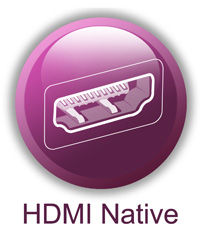Native HDMI
HIS Technology, January 1, 2008

A system with an ATI RadeonTM HD 4800 Series graphics card can help enhance the HD entertainment experience by providing a seamless connection to an HDTV or home theater system. With built-in 7.1 surround sound audio (AC3 / DTS ), the new GPUs and graphics cards support single cable connection directly to a compatible HDTV, projector or receiver. This single cable carries both the HD video and 8 channel audio for a clean, high definition connection. It will be equipped with an HDMI connector. These options give consumers more options and flexibility when connecting their PCs to monitors or home theaters for maximum enjoyment of HD content. The new GPU also supports xvYCC color which can display a wider range of color when connected to capable HDTVs.
The HDMI interface is the uncompressed, all-digital, global connectivity standard that delivers true HD quality for consumer electronics and PC products via a single cable.
HDMI technology was specifically designed to meet the needs of today’s – and tomorrow’s – HD entertainment systems. It transmits digital video, multi-channel surround sound, and advanced control data through a single cable, replacing up to eleven older cables with a single connection. Its simplicity is matched only by its extraordinary performance. High-bandwidth, all-digital, and never compressed, HDMI provides the highest possible signal quality.
More than 800 manufacturers have adopted the HDMI standard since 2003. With 229 million HDMI-enabled devices shipping in 2008, and 300 million more projected in 2009, analysts expect to see over a billion HDMI devices in the market by 2010, when every new digital TV will feature at least one HDMI port. HDMI connectivity is already standard on a wide range of products, from HDTVs and Blu-ray Disc players to multimedia PCs, gaming systems, digital camcorders, and more.
HDCP
HDMI can use HDCP to encrypt the signal if required by the source device. CSS, CPPM, and AACS requires the use of HDCP on HDMI when playing back encrypted DVD-Video, DVD-Audio, and Blu-ray Disc. The HDCP Repeater bit controls the authentication and switching/distribution of an HDMI signal. According to HDCP Specification 1.2 beginning with HDMI CTS 1.3a, any system which implements HDCP must do so in a fully-compliant manner. HDCP testing which was previously only a requirement for optional tests such as the "Simplay HD" testing program is now part of the requirements for HDMI compliance. HDCP allows for up to 127 devices to be connected together with up to 7 levels using a combination of sources, sinks, and repeaters. A simple example of this is several HDMI devices connected to an HDMI AV receiver that is connected to an HDMI display.
There are devices called HDCP strippers which can remove the HDCP information from the video signal and allows the video to be playable on non-HDCP compliant displays. An example of an HDCP stripper for HDMI is the HDfury2 which can convert the video to VGA or component video and the audio to stereo analog or digital TOSLINK.